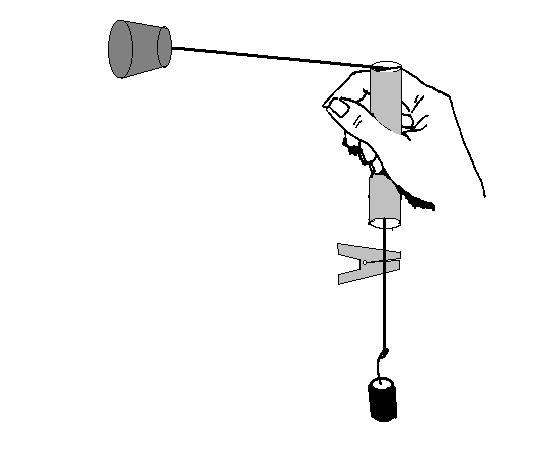
Uniform Circular Motion Lab
This experiment investigates how the force necessary to maintain a body in uniform circular motion (i.e. in a circle of constant radius and with a constant speed) is related to the speed of the object experiencing UCM. You should note that there are other possibilities for the independent variable. We are keeping all of the possible independent variables fixed save the applied force.

Your apparatus, shown in figure 1, consists of a glass tube, some string, a rubber stopper, and an alligator clip. The force that keeps the rubber stopper traveling in a circle at constant speed is supplied by the string. The source of the force is gravity pulling down on a mass attached to the lower end of the string. If we ignore the friction of the string on the glass tube, the force downward on the mass due to gravity is the same as the force inward on the stopper. Hence the force is Mhanging g and the velocity can be calculated using the circumference of the circle and the time for one circle. If we tried to just measure the time for one circle of the stopper, the experimental error would be very large due to your delayed reaction time in turning on and off the stopwatch. To get a more accurate answer you will measure for thirty complete circles. In addition to minimizing the error due your reaction time this also averages any variations in speed that occur while you are swinging the stopper.
Before you begin your experiment, check your glass tube for chipped edges. Measure the mass of your stopper. (You won't need it until the end, but measuring it now makes sure you don't forget to do it.) Thread the string through the tube. Attach the stopper to one end and 150 g of mass to the lower end. Stretch the apparatus out on your lab table and position the stopper so that the distance between the stopper and the top of the tube is 50 cm. Attach the alligator clip about 2 cm below the bottom of the tube. Holding the tube in one hand, start swinging the stopper slowly in a circle above your head. As you swing faster, the clip will rise. This happens because your mass can't supply enough force to keep the stopper from moving out. Thus, the radius increases and the force needed to maintain UCM will then decrease (due to the larger radius the needed acceleration is smaller). After a little practice, you should be able to maintain the alligator clip about 2 cm below the bottom of the tube. When this is the case, we know the radius of the circle is 50 cm and that the applied force is the weight of the hanging mass. Have a partner start a stopwatch and time the amount of time needed for thirty complete revolutions. You should concentrate on trying to keep the alligator clip in a steady position 2 cm below the bottom of the tube. Once the time has been measured, record your data in a table (similar to the example below) and proceed on to other masses. You should acquire additional data for hanging masses of: 20, 30, 50, 100, 200, 250, and 280 grams. Calculate the force applied, and the resulting velocity for each case and complete the table.
Mhanging (kg) |
Time (s) |
v (m/s) |
Fhang (N) |
Once your table is complete, plot a graph of velocity vs. applied force. (Applied force is the independent variable and velocity is the dependent variable.) Look at the shape of the graph to get figure out what the relationship between velocity and force might be. If the relationship is not linear, use the shape to figure out how to re-plot the graph in such a manner as to obtain a straight (or straighter) line. Draw in the best fit line and determine the equation which describes the line. Print both the original graph and the new graph.
Use Newton's second law and your knowledge of circular motion to predict what the slope of your line should be. Calculate this theoretical slope. Compare this theoretical slope with the slope that you got from your best fit line. How well do they agree? Make a verbal comparison and also calculate the percentage difference between the experimental and theoretical slopes. Which is larger? What are some possible experimental reasons that the two might not agree? For one of the possible sources of error, think about whether it would tend to increase or to decrease the measured slope? Explain your reasoning.